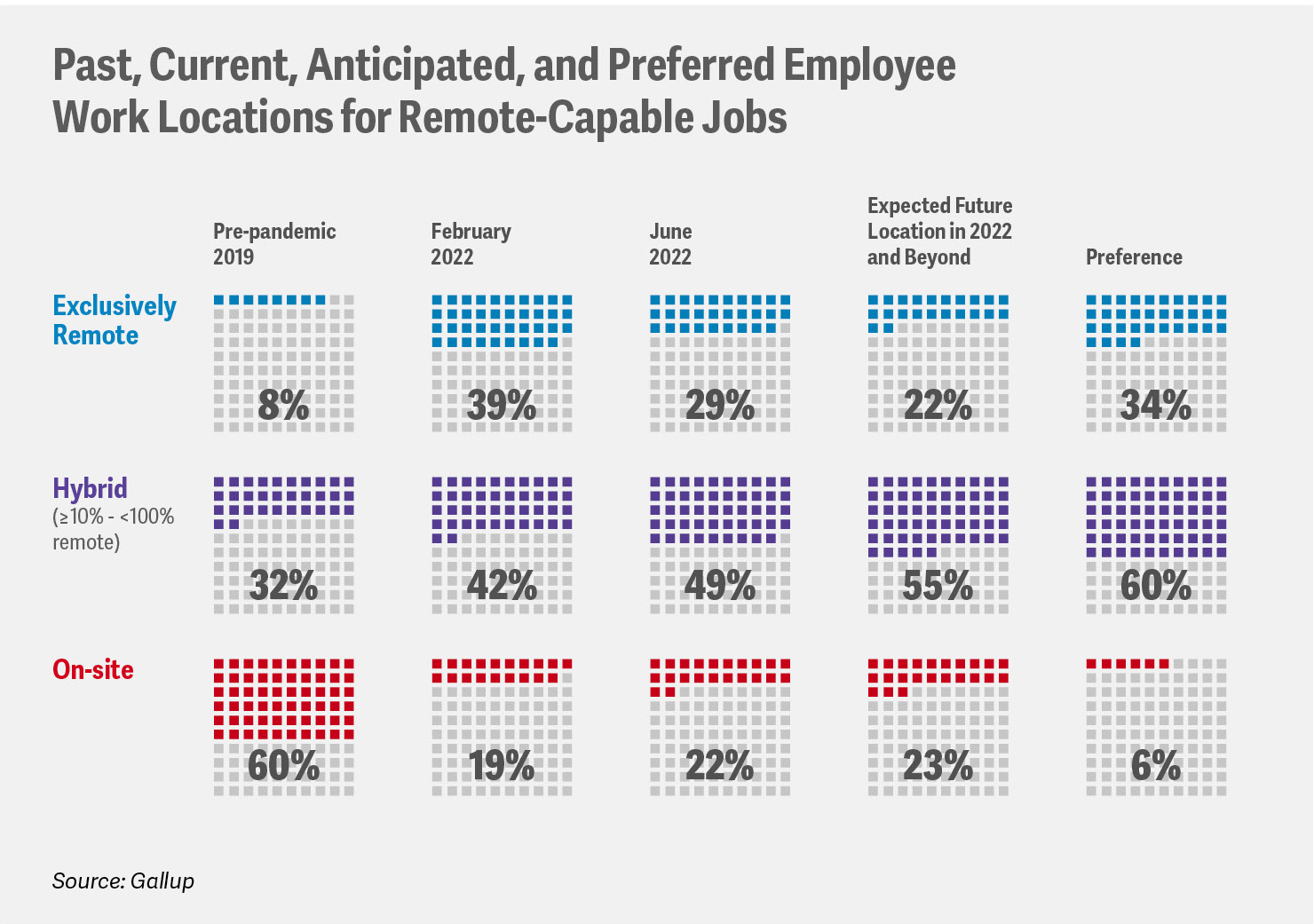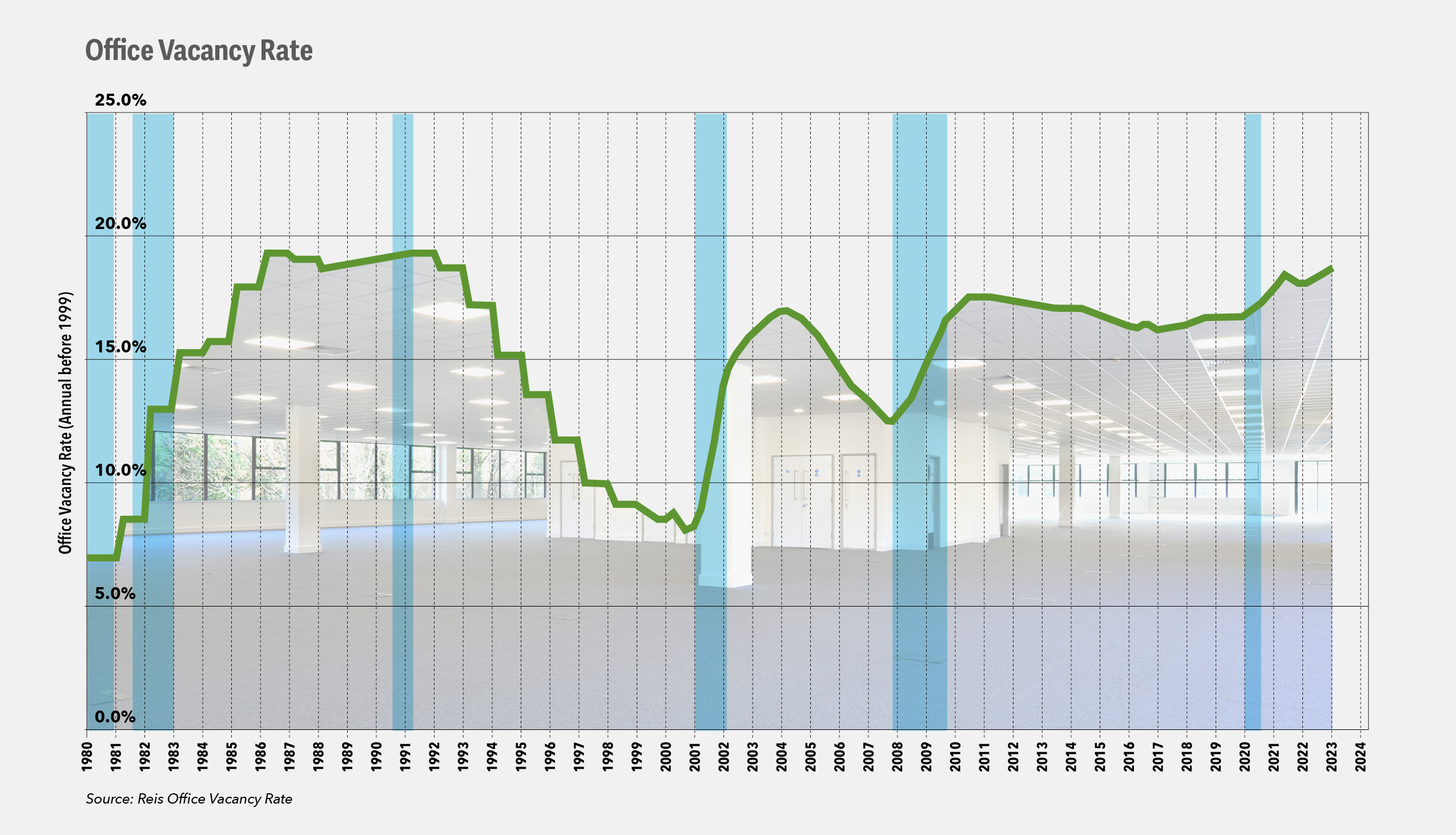Hybrid Work is Here to Stay

In this article we discuss how the perpetuation of pandemic-driven remote working is impacting demand for office space, increasing vacancy rates and weighing on investors, owners and lenders.
It appears that the hybrid workforce is here to stay, leaving the future of traditional office space largely unknown. As return-to-office policies continue to evolve, an increasing number of companies are either embracing or adjusting to, the reality that accommodating some level of remote workforce is now an inevitability.
When workers packed up their laptops and work documents, and walked out of their offices in March of 2020 in compliance with U.S. stay at home mandates, few employer/tenants, landlords or lenders could have imagined what would ensue. The state of the workforce today isn’t merely a function of employees not wanting to return to an office environment on either a full or part time basis. In more cases than one might imagine, companies are coming to realize that they can, in fact, operate effectively and with great efficiency under some level of remote worker scenario. Collectively, these businesses occupy tens of millions of square feet of office space in some of the nation’s most historically valuable urban real estate markets.

Regardless of their motivation, as more companies embrace or acquiesce to the reality of remote work, companies have started to shrink their physical footprint and demand for office space simply is not meeting supply. As a result, that supply surged from the start of the COVID pandemic to a 2022 Q3 national vacancy rate of 19.1%. This lower demand for office space is leading to widespread concerns that office buildings could become a less valuable asset class, which has significant implications for owners, lenders and institutional investors. Further, the concentration of office assets in urban areas poses potential fiscal challenges for local governments, which rely heavily on property taxes levied on commercial offices and related retail spaces.
For example, the New York City office market has been significantly impacted by the remote work trend, with debt repayment coming due and rising interest rates causing stress for the office asset class:
- In 2022 Q3, the overall office space vacancy rate in Manhattan was 15.4%.
- Inflation, recession concerns, geopolitical complexities, and other factors continue to weigh on the potential for robust return to the office.
- With lease revenue and total number of leases declining, office values in New York City are now expected to drop 28% by 2029 – representing value destruction of $49 billion – according to a new study conducted by academics at New York University and Columbia University.
Extrapolating the NYU/Columbia study, titled “Work From Home and the Office Real Estate Apocalypse” to the national office market, the report estimates that about $500 billion in office asset value could vanish by 2029 as the same dynamic plays out in areas where remote workers spend more time outside centralized office spaces.

Not all office assets have been or will be impacted equally. Employer/employee preferences have resulted in a “flight to quality” with demand high for new and innovative higher-quality (Class A) office space, while older (Class B & C) properties see increases in vacancies. According to Cushman & Wakefield, there is strong demand in New York City for new space in Hudson Yards and One Vanderbilt; 84% of leasing activity in the midtown area occurring in class A buildings. This dynamic led to 2022 Q3 vacancy rates of 14.5% for class A buildings compared to 17.2% for class B buildings. The spread between vacancy rates for newer Class A and older B and C class buildings is expected to become even more pronounced in primary markets due to significantly older inventories than in midsized metro areas. For example, more than 70% of existing office space in New York, San Francisco, Los Angeles, Boston, Chicago and Philadelphia is more than 30 years old. To win new tenants, owners will need to meet demand for space that takes into account employee work-life balance needs, such as gym facilities, outdoor spaces, social spaces, safety concerns, close proximity to transit and touchless technology, to name a few. An owner’s ability to react to these trends has been negatively impacted by inflation, labor and supply chain issues, which increases construction costs and delays and can lead to liquidity issues.
Even as the pandemic’s influence fades from our daily lives, New York’s office market will face yet another obstacle, debt repayment. More than $7 billion of commercial mortgage-backed securities debt belonging to office buildings in the city is set to mature this year, according to market research firm Trepp. In fact, the office debt due to expire this year exceeds the previous three years combined and is a direct result of borrowers extending loan terms during the pandemic. Finding replacement debt may prove a tough sell for building owners. As leases expire, many tenants are still determining their ultimate course relative to a hybrid workforce and are uncertain of future space requirements. The current rising interest rate environment also complicates the picture, making loans more expensive for building owners.
Higher vacancy rates for older buildings and maturing debt will continue to weigh on investors, owners and lenders. So, what should they be thinking about as they navigate an increasingly complex office environment? We view planning as essential and suggest use of a road map to help answer critical questions such as:
- How to negotiate with lenders?
- What to do with empty space?
- Should the building be converted to another form of space? (i.e., residential)
- Does location and demand constrain potential for a conversion?
- What are the capital investments/renovations needed to attract tenants?
- If the owner(s) sell the property, what impact will rising interest rates have on valuation?
- If the owner(s) need to borrow at higher rates, can they generate enough cash flow to cover their obligations?
If a property is showing signs of financial stress, the owner(s) may want to know:
- How does the current lender think about investing in or financing the office space? What will a new lender require to refinance the property?
- If in financial distress, the owner(s) may want to proactively engage the lender with a plan for the building or space. Should this be done prior to a potential default?
Lenders will want to know that they are not the only financial solution to a stressed or distressed situation:
- Will the owner(s) put in more capital?
- Will the owner(s) find a partner to help fund a restructuring if they don’t have the required capital?
- Can the parties restructure the loan(s)?Is there an opportunity for reduced amortization, interest only, or another interim solution.
Ultimately, the extent of a tenant and its employee’s return to the office in major markets such as New York is going to be based largely on the property owner’s ability to read the current market and adapt nimbly. Modern, higher-quality, amenity-rich buildings in prime locations are certainly likely to win out over others. But will the differentiator be a state-of-the-art gym, an outdoor roof deck recreation area, plush indoor social space or some other innovative offering waiting to be brought to market? And what is the winning solution if a landlord is willing to invest but its location or some other aspect of its property is not optimal for tomorrow’s hybrid employers and workers? The office real estate market is clearly on a path toward recovery, but the road ahead has many twists, turns and dead ends that will require skillful navigation. have yet to be navigated. journey remains a work in progress.
Getzler Henrich provides a full array of turnaround, workout, crisis and interim management, corporate restructuring, bankruptcy, financial advisory and distressed M&A services. We work with public and private corporations as well as family-owned businesses, under a variety of capital and debt structures. Our worldwide client base spans the full spectrum of industries, from the healthcare and retail sectors to oil and gas, to manufacturing and distribution.




